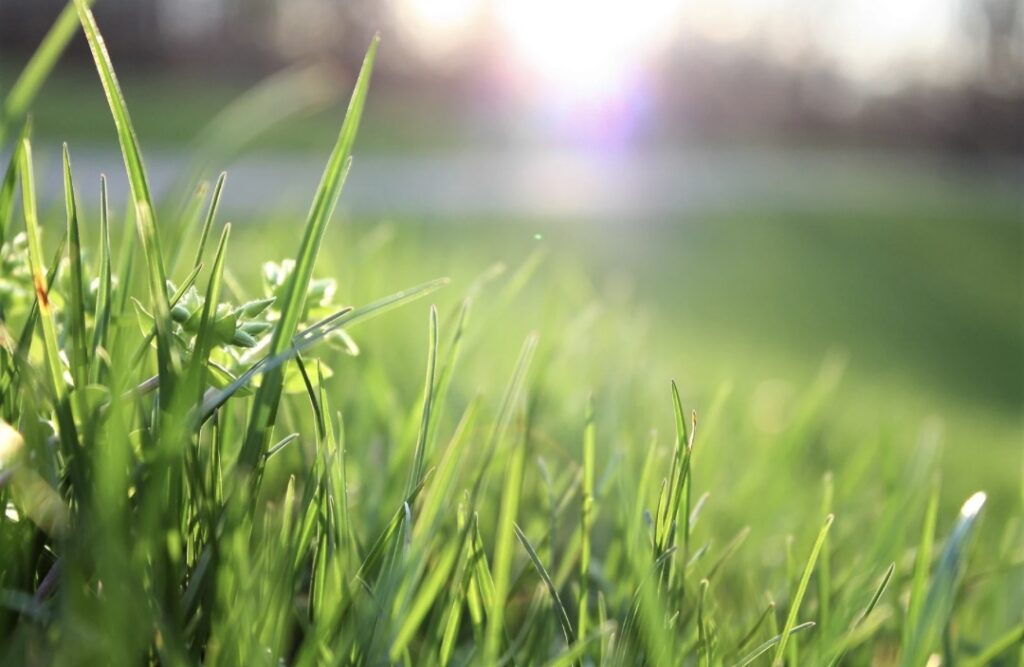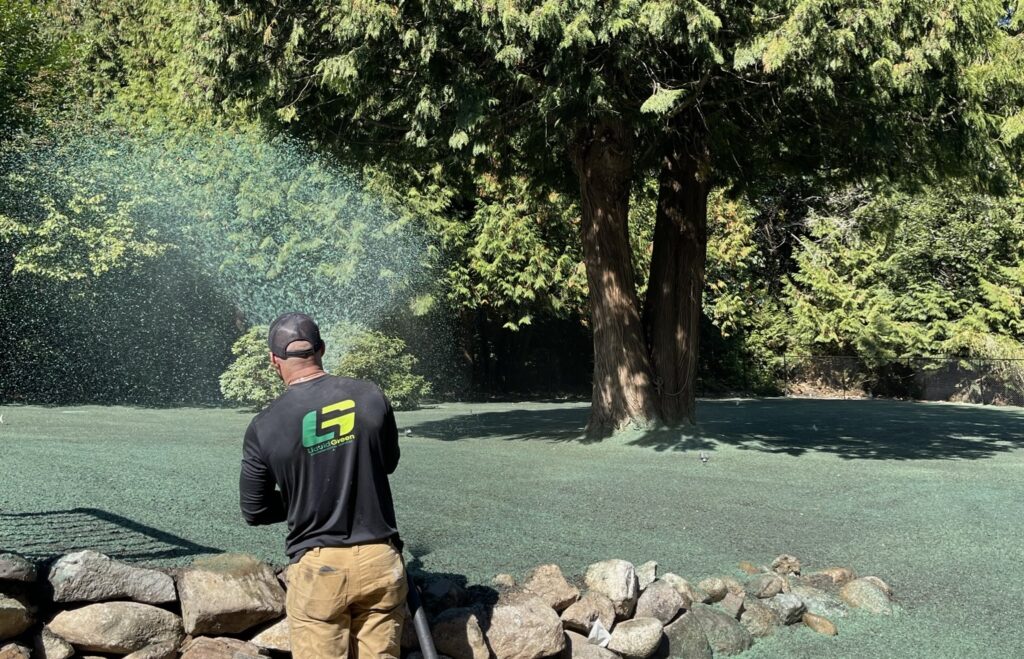Discover the secrets to a vibrant lawn with the Ultimate Guide to Overseeding. Read more to learn what is overseeding and how every lawn can benefit from it. Unveiling the best time to overseed along with the essential steps for lush turf, this comprehensive guide ensures your lawn thrives. Dive into innovative techniques, including the game-changing option of hydroseeding. Explore the benefits of hydroseeding for your overseeding project, revolutionising traditional approaches. Whether you're a lawn care enthusiast or a novice, this guide caters to all levels of expertise. Ready to transform your lawn? Consider the efficiency of hydroseeding services and the breakthrough in achieving dense, healthy turf.
Understanding the Basics of Overseeding a Lawn
Understanding the basics of overseeding your lawn is crucial for cultivating a healthy and resilient lawn. Let's dive into the breakdown of the key benefits:
- Density: Overseeding contributes to the gradual improvement of lawn density over time. By introducing new grass seeds, you fill in gaps, promoting thicker and fuller turf.
- Appearance: A thicker lawn not only looks more lush and inviting but also enhances the overall aesthetic of your outdoor space. When you reseed a lawn, it transforms sparse grass into a visually appealing expanse of green.
- Weeding: With a denser lawn, there is limited space for weeds to take root. Overseeding acts as a natural weed control method, reducing the need for chemical interventions and maintaining a weed-free lawn.
- Disease Resistance: While not all grass types exhibit increased disease resistance, selecting grass seeds known for their resistance can contribute to a healthier lawn. This proactive approach helps minimise the risk of diseases affecting your turf.
- Adaptation: Overseeding promotes adaptability in your lawn. The introduction of diverse grass varieties helps the lawn withstand various environmental stressors, ensuring long-term health and vitality.
- Repair: Ideal for addressing bare patches and thinning areas, overseeding serves as a cost-effective solution for lawn repair. It accelerates the recovery of damaged sections, restoring uniformity to the turf.
- Improved Turf: Ultimately, overseeding is a holistic practice that leads to improved turf quality. It enhances the overall health and resilience of your lawn, resulting in a more robust and enduring green space.

When to Overseed Your Lawn
First, you must determine when is the best time to overseed your lawn. Springtime, spanning from March to early May, and late summer through early autumn, from the end of August to September, are generally considered ideal periods for when to reseed your lawn.
Climate plays a pivotal role in this decision-making process for overseeding your lawn and when to reseed a lawn. For instance, warm-season grass flourishes when overseeded in midsummer or spring, whereas cool-season grass thrives best when overseeded in the fall. Soil temperature is another crucial factor; cool-season grasses germinate optimally at temperatures between 10-18°C, while warm-season varieties prefer a warmer range of 21-32°C.
Establishment is paramount, allowing the grass to set in before cooler temperatures or winter arrives. When deciding between overseeding with cool or warm-season grasses, considerations include growth rates, water requirements, and resilience to temperature fluctuations. A careful evaluation of these factors ensures a strategic approach, leading to a thriving and resilient lawn.
Cool Season Grasses
If your region has cool season grass, it is recommended to overseed in fall. The cool temperatures characteristic of autumn align perfectly with the preferences of cool-season grass, promoting robust growth. Fall's increased moisture levels provide a conducive environment for germination and sustained development, while the season's diminished weed activity ensures a cleaner lawn. Crucially, overseeding in fall allows the grass to establish itself before winter sets in, fortifying it against the challenges of the colder months. If you're tackling patchy lawns in the Vancouver area, explore the efficient hydroseeding solutions that Liquid Green has to offer!
Examples of Cool Season Grasses:
- Fescue
- Bluegrass
- Ryegrass
Cool Temperatures for Cool Grass: The fall season's cooler temperatures align perfectly with the preferences of cool-season grass, fostering ideal conditions for lawn overseeding.
Moisture Boost in Fall: Fall brings increased moisture, creating a conducive environment for germination and sustained growth during the overseeding process.
Weed Management: With reduced weed activity in the fall, overseeding during this season minimises competition and ensures a cleaner, healthier lawn.
Establishment Before Winter: Overseeding in the fall allows the grass to establish itself robustly before winter, fortifying the lawn against the challenges of the colder months.
Warm Season Grasses
Often, home and business owners overseed a lawn in spring. If your region features warm-season grasses, spring overseeding is best.
Examples of Warm Season Grass:
- Bermuda
- Zoysia
- St. Augustine
Thriving in Warm Temperatures: Warm-season grasses are optimised for growth in higher temperatures, making the spring overseeding ideal for growth. Warmer conditions facilitate successful germination and robust growth.
Long Growth Season: When you overseed a lawn in the spring, take advantage of the extended growth season ahead. This prolonged period allows for the establishment of the grass before winter sets in, ensuring a strong and healthy lawn.
Although spring overseeding can be the best time to overseed a lawn, it really depends on the type of grass your region features, our team at Liquid green will help you find your region's grass type and effective solutions to enhance warm-season grass lawns.
What About Unpredictable Weather?
Navigating unpredictable weather requires a strategic approach to overseeding your lawn. To combat uncertainties, follow these key steps:
- Monitor Soil Temperature: Keep a close eye on soil temperature, a critical factor year-round. Ensure the optimal temperature range for your climate is met before initiating overseeding.
- Flexibility: Be adaptable in your approach. If ideal temperatures are reached outside the usual time frames for your region, consider adjusting your overseeding schedule.
- Seed Selection: Choose seeds carefully based on your region. Reference tables for recommended grass varieties that thrive in your climate.
- Preparation for Extremes: Anticipate extreme weather conditions and be prepared to delay overseeding if necessary.
- Irrigation Planning: Don't rely on unpredictable rain. Have a well-thought-out irrigation plan in place to ensure consistent moisture for germination.
- Protection Measures: Consider using mulch or seed blankets if needed to protect newly seeded areas.
- Monitoring: Stay vigilant by keeping a close eye on upcoming weather forecasts. This allows for quick action or adjustments if unforeseen challenges arise during the overseeding process.

How to Overseed Your Lawn Effectively
To overseed your lawn effectively, adopt a three-phase approach. Overseeding steps break down the process into distinct phases, ensuring a comprehensive and successful outcome.

- Preparation: Commence the overseeding process with thorough preparation. This involves assessing and addressing existing lawn conditions, including mowing, aerating, and removing debris. Creating an optimal seedbed is crucial for successful germination.
- Seed Distribution: The second phase involves meticulous seed distribution. Choose quality seeds suited to your region and apply them evenly across the prepared area. Employing a broadcast spreader ensures uniform coverage, promoting consistent growth.
- Post Overseeding Care: After seed distribution, shift focus to post-overseeding care. Maintain adequate moisture through regular watering, ensuring the newly seeded area remains damp for optimal germination. Monitor the lawn closely for signs of growth, and adjust care practices as needed to foster a thriving, lush turf.
Preparing Your Lawn for Overseeding
For effective prep when overseeding a lawn, follow these steps:
- Evaluate your lawn's condition.
- Mow existing grass to an appropriate height.
- Perform dethatching to remove debris.
- Aerate the soil for optimal seed-to-soil contact.
- Conduct a soil test to determine nutrient levels.
- Choose the right seed variety suited to your region for successful overseeding.
1. Lawn Evaluation
Begin your overseeding lawn process by assessing your lawn's current condition. Identify areas with thin grass, bare spots, or heavy weed infestations. Utilise a lawn journal to meticulously track and document these issues, noting improvements over time. This strategic approach allows you to target specific problem areas during overseeding, ensuring a more focused and effective enhancement of your lawn's overall health and appearance.
2. Mow Your Lawn
Before lawn overseeding, mow strategically by cutting the grass shorter than usual, but avoid scalping it. Gradually lower the mower height over a few sessions to prevent shock to the grass. Leaving the grass clippings on the lawn after mowing provides valuable nutrients, enhancing the soil's health. This meticulous mowing technique sets the stage for successful overseeding, ensuring an optimal environment for new seed growth and promoting a lush, well-nourished lawn.
3. Dethatching
Prepare for overseeding by dethatching your lawn to eliminate the layer of thatch (dead grass and debris). Use a dethatching rake or machine, especially for larger lawns. Employ a technique of dethatching in two directions for thorough removal. Consider composting the collected thatch to recycle its nutrients, promoting a healthier soil environment. This step ensures that seeds can easily reach the soil, facilitating successful overseed grass and promoting robust growth for a revitalised and lush lawn.
4. Aeration
Aerating your lawn is crucial for improving soil compaction, allowing essential air, water, and nutrients to reach the roots. Utilise a spike or core aerator for best results, focusing on high-traffic areas with compacted soil. Employ the technique of overseeding a lawn immediately after aeration to enhance grass growth and density. Additionally, water the lawn a day before aerating to soften the soil, optimising the aeration process. This comprehensive approach promotes a lush and healthy lawn, addressing compaction concerns and fostering the growth of a resilient and vibrant grass cover.
5. Soil Testing and Amendment
Enhance soil health before overseeding by aerating your lawn, alleviating compaction and facilitating root access to air, water, and nutrients. Opt for a spike aerator or a core aerator for optimal results, focusing on areas with heavy foot traffic and compacted soil. To ease the process, water the lawn a day before aerating to soften the soil. This strategic step ensures a more conducive environment when you overseed a lawn, fostering improved nutrient absorption and promoting a thriving, resilient lawn.
6. Overseed Selection
When overseeding a lawn, choose a seed mixture tailored to your local weather conditions. Factor in maintenance requirements and shade tolerance to ensure the selected seeds thrive in your specific environment. This thoughtful selection ensures a successful overseeding lawn process and promotes a healthy, vibrant lawn.

Should You Fertilise Before Overseeding?
Fertilising before overseeding can be beneficial, but it's crucial to approach it correctly. Study soil test results to identify nutrient deficiencies and select the appropriate fertiliser. Applying fertiliser just before or during overseeding ensures that essential nutrients are readily available for new grass seeds during germination. This strategic timing optimises the establishment of a lush and healthy lawn. However, a judicious approach, tailored to the specific needs of your soil, is key to achieving optimal results and promoting the long-term vitality of your overseeded lawn.
Seed Distribution
Following preparation, the pivotal next phase in the overseeding process is the distribution of seeds. With a well-prepared seedbed, evenly spread the selected seeds across the targeted areas. Utilise a broadcast spreader for larger sections, ensuring uniform coverage. The key is to distribute the seeds consistently, avoiding clumps or sparse patches. This phase sets the foundation for robust germination and uniform growth, contributing to the overall health and density of the lawn. Precise seed distribution, coupled with preparatory steps, forms a comprehensive approach when learning how to overseed a lawn.
Method for Even Seed Distribution
For uniform seed distribution, divide the seed into two equal portions. Spread one part in a north-south direction and the other in an east-west direction, ensuring comprehensive coverage when you overseed a lawn.
TIP: To avoid over- or under-seeding, calibrate the spreader according to the seed manufacturer's recommendations. Additionally, mark areas with high and low seed density for effective monitoring of growth patterns. This meticulous method, coupled with proper calibration, guarantees an even dispersal of seeds, fostering optimal germination when you overseed your lawn.
Tools for Optimal Seed Spreading
Selecting the right tools for overseeding a lawn is crucial. Employ a broadcast spreader or drop spreader for even seed distribution across larger areas. For smaller patches, manual distribution by hand is effective. When dealing with challenging or larger spaces, Liquid Green's equipment, such as the Finn T120 Hydroseeder, offers distinct advantages. The Finn T120 facilitates efficient overseeding in hard-to-reach areas and large expanses, ensuring uniform seed coverage. This specialised equipment aligns with the precision needed for successful overseeding, enhancing the process and contributing to the establishment of a lush and healthy lawn.
Light Raking and Rolling
After overseeding a lawn, lightly rake the area to ensure optimal seed-to-soil contact. Utilise a lawn roller to press the seed into the soil, but exercise caution to prevent soil compaction. Roll consistently to cover the entire area, minimising the risk of missing spots. When raking, employ a gentle technique to avoid displacing the seeds excessively. This meticulous approach promotes successful germination, contributing to the establishment of a lush and resilient lawn after overseeding.

Post-Overseeding Care: Ensure the Best Results for Your Lawn
Overseeding lawn encompasses a series of customised practices that foster the growth of young seedlings. These measures ensure their robust establishment, seamlessly integrating them with your existing turf. This tailored approach promotes a denser, healthier lawn, enhancing overall resilience and visual appeal.
Watering Schedule
Maintain a strategic overseeding watering schedule. Keep the top inch of soil consistently moist, avoiding waterlogging.
- In the initial two weeks, water at least once a day, using a fine mist spray to prevent seed displacement.
- In weeks 3-4, shift to watering every other day, ensuring moisture reaches about 2 inches deep.
- After the first month, transition to a regular overseeding watering schedule of once or twice a week.
TIP: To reduce evaporation and fungal growth, water early in the morning. This thoughtful approach fosters optimal germination and the establishment of a healthy, overseeded lawn.
Fertilising
Strategically fertilise while overseeding for optimal results. Initially, use starter fertiliser with higher phosphorus content to bolster root development. Subsequent applications should align with the grass type and its growth stages, with a possible follow-up 4-6 weeks after germination. Avoid over-fertilizing to prevent lawn burns and uneven growth. Importantly, steer clear of weed-and-feed products as they can hinder seed germination. This fertilisation approach ensures proper nourishment when you overseed a lawn, fostering growth and long-term grass health without compromising the germination process.
The First Mowing
Delay mowing until the new grass reaches a minimum height of 3 inches after overseeding. Mow at the appropriate height for your grass type, avoiding excessively short cuts. Maintain sharp mower blades for a clean and healthy cut. Additionally, vary mowing patterns regularly for subsequent mowings to prevent soil compaction and minimise stress on the grass, promoting an even and resilient overseed grass.
Stay Off the Lawn
Minimise foot traffic on the recently overseeded lawn until the grass is fully established. Employ temporary barriers or signs to remind others to avoid walking on the seeded sections. Strategically plan overseeding during periods of lower lawn usage to facilitate undisturbed growth. This precautionary approach ensures that the new grass has ample time and space to establish itself, contributing to the successful development of a healthy and flourishing lawn after overseeding.
Managing Pests and Diseases
For effective pest and disease management while overseeding, be proactive in prevention:
- Regularly inspect the lawn for signs of pests or diseases.
If a disease is identified, refrain from walking in affected areas to prevent it from spreading. Consider fungicides and pesticides as a last resort, applying them only when necessary.
This vigilant and cautious approach safeguards the newly overseeded lawn, promoting its health and resilience against potential threats.
Reseeding Patchy Areas
In some cases, you may need to reseed patchy areas after overseeding to achieve uniform growth. This means that often you will overseed new grass. However, hydroseeding eliminates the need for additional reseeding. To provide efficient and effective overseeding solutions, explore the benefits of spray grass seed services.
Shade Management
Address patchiness caused by excessive shade by pruning nearby trees to enhance sunlight exposure. For persistently shaded areas, select grass varieties or ground cover that thrive in shaded conditions. This strategic approach ensures optimal growth, fostering a lush and consistent lawn even in areas with limited sunlight when overseeding a lawn.

Post-Overseeding Care: Ensure the Best Results for Your Lawn
Overseeding lawn encompasses a series of customised practices that foster the growth of young seedlings. These measures ensure their robust establishment, seamlessly integrating them with your existing turf. This tailored approach promotes a denser, healthier lawn, enhancing overall resilience and visual appeal.
Watering Schedule
Maintain a strategic overseeding watering schedule. Keep the top inch of soil consistently moist, avoiding waterlogging.
- In the initial two weeks, water at least once a day, using a fine mist spray to prevent seed displacement.
- In weeks 3-4, shift to watering every other day, ensuring moisture reaches about 2 inches deep.
- After the first month, transition to a regular overseeding watering schedule of once or twice a week.
TIP: To reduce evaporation and fungal growth, water early in the morning. This thoughtful approach fosters optimal germination and the establishment of a healthy, overseeded lawn.
Fertilising
Strategically fertilise while overseeding for optimal results. Initially, use starter fertiliser with higher phosphorus content to bolster root development. Subsequent applications should align with the grass type and its growth stages, with a possible follow-up 4-6 weeks after germination. Avoid over-fertilizing to prevent lawn burns and uneven growth. Importantly, steer clear of weed-and-feed products as they can hinder seed germination. This fertilisation approach ensures proper nourishment when you overseed a lawn, fostering growth and long-term grass health without compromising the germination process.
The First Mowing
Delay mowing until the new grass reaches a minimum height of 3 inches after overseeding. Mow at the appropriate height for your grass type, avoiding excessively short cuts. Maintain sharp mower blades for a clean and healthy cut. Additionally, vary mowing patterns regularly for subsequent mowings to prevent soil compaction and minimise stress on the grass, promoting an even and resilient overseed grass.
Stay Off the Lawn
Minimise foot traffic on the recently overseeded lawn until the grass is fully established. Employ temporary barriers or signs to remind others to avoid walking on the seeded sections. Strategically plan overseeding during periods of lower lawn usage to facilitate undisturbed growth. This precautionary approach ensures that the new grass has ample time and space to establish itself, contributing to the successful development of a healthy and flourishing lawn after overseeding.
Managing Pests and Diseases
For effective pest and disease management while overseeding, be proactive in prevention:
- Regularly inspect the lawn for signs of pests or diseases.
If a disease is identified, refrain from walking in affected areas to prevent it from spreading. Consider fungicides and pesticides as a last resort, applying them only when necessary.
This vigilant and cautious approach safeguards the newly overseeded lawn, promoting its health and resilience against potential threats.
Reseeding Patchy Areas
In some cases, you may need to reseed patchy areas after overseeding to achieve uniform growth. This means that often you will overseed new grass. However, hydroseeding eliminates the need for additional reseeding. To provide efficient and effective overseeding solutions, explore the benefits of spray grass seed.
Shade Management
Address patchiness caused by excessive shade by pruning nearby trees to enhance sunlight exposure. For persistently shaded areas, select grass varieties or ground cover that thrive in shaded conditions. This strategic approach ensures optimal growth, fostering a lush and consistent lawn even in areas with limited sunlight when overseeding a lawn.
Overseeding Lawn: How Long Will It Take for Full Growth?
Learning how to overseed a lawn can be time consuming. The timeline for full grass growth varies, but hydroseeding typically accelerates the process of lawn overseeding with traditional methods. With hydroseeding, you can expect quicker germination and the establishment of a lush lawn. This method's advantages lie in its efficiency and ability to provide a uniform and rapid growth.Delve deeper into what is hydroseeding on Liquid Green's blog. This informative resource sheds light on the hydroseeding process and its advantages for achieving a vibrant and thriving lawn in a shorter time frame.
Your Takeaway
Achieving a healthy grass when you overseed a lawn involves meticulous preparation—mowing, dethatching, aerating, and soil amendment lay the groundwork for success. Ensuring optimal seed-to-soil contact is vital for germination. Post-seeding care, including consistent watering and maintenance, supports the young grass as it establishes. While the process demands time, patience, and ongoing care, seeking assistance from professionals like Liquid Green becomes advantageous, especially for covering expansive areas. Their expertise will provide information about when to overseed, efficient and effective overseeding and knowledge on contributing to long-term grass health.


